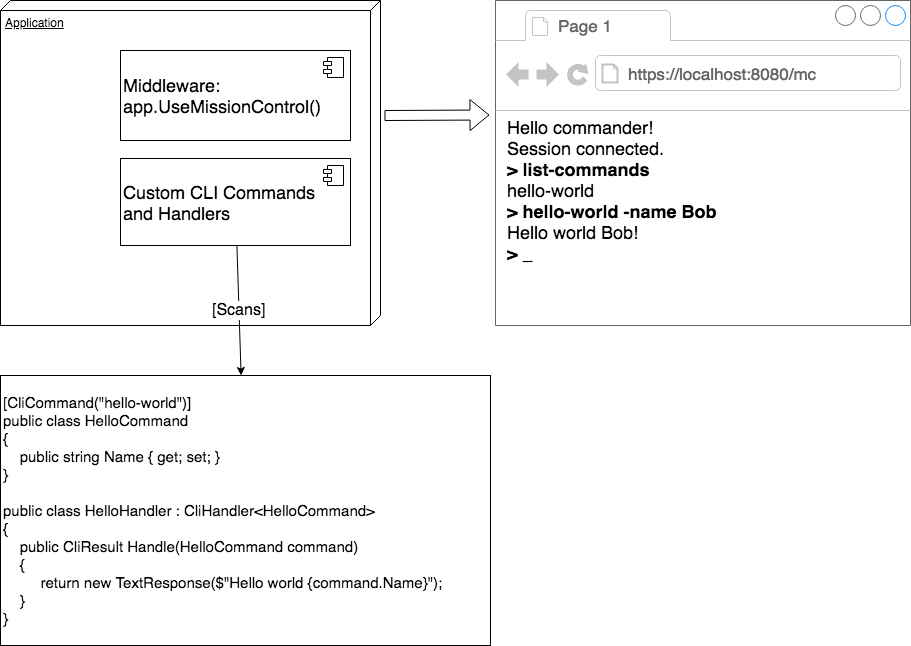CLI as a middleware for your web apps and microservices
Example web site with MC console: https://mc-sample.azurewebsites.net/
UNDER DEVELOPMENT - alpha version
Often we want to add some kind of interaction with our application. For example:
- purge cache
- check some background tasks
- state of objects or queues
- resources consumption
- add new user to database, update database records
- etc
MissionControl serves CLI web terminal on a dedicated URL and executes custom commands created by application developer. There are some generic commands already bundled with this library, like list-commands, help and diagnostics. Custom commands are easy to add by just implementing an interface or adding an attribute, and MissonControl will handle the rest.
- just a middleware for any .NET Core app
- serves CLI UI interface on dedicated URL (/mc by default)
- automatically registers all commands/handlers in the app
In Startup.cs register services and add a middleware:
public void ConfigureServices(IServiceCollection services)
{
// registers internal dependencies, scans this assemly for commands
services.AddMissionControl();
}
public void Configure(IApplicationBuilder app)
{
// registers /mc endpoint
app.UseMissingControl();
}With custom configuration:
- all assemblies that contains commands and command handlers
- Url where CLI is served
- authentication callback - add your own request authentication to prevent execution of commands in production
public void ConfigureServices(IServiceCollection services)
{
// assemblies where commands and handlers are located
services.AddMissionControl(typeof(PurgeCacheCommand).Assembly, typeof(ListActiveUsersCommand).Assembly);
}
public void Configure(IApplicationBuilder app)
{
app.UseMissingControl(opt =>
{
opt.Url = "/mc";
opt.Authentication = req => true; // this allows all requests, but add authentication for production deployments!
});
}Simple command and handler example:
// Gets exposed to CLI as a command:
// > say-hi -name=Batman -foo=123
[CliCommand("say-hi", "Say Hi!")]
public class SayHiCommand : CliCommand
{
public string Name { get; set; }
[CliArg(required: false, help: "Attribute is optional")]
public int Foo { get;set; }
}
public class SayHiHandler: ICliCommandHandler<SayHiCommand>
{
// IService is resolved with standard asp.net ioc
public SayHiHandler(IService service) { }
public async Task<CliResponse> Handle(SayHiCommand command)
{
await DoSomeAsyncWork();
return new TextResponse($"Computer says hi to {command.Name}!");
}
}Invoked in CLI console with:
> say-hi -name=Hackerman
Computer says hi to Hackerman!
> _
- TextResponse: simple text message
- ErrorResponse: text message with error UI
- MultipleResponses: async (chunked) responses
- TableResponse: collection of objects rendered as a table
Sometimes you want to "stream" responses back to the client while executing some long-running task on the server.
For multiple responses we can yield strings:
[CliCommand("multi-resp", "Multiple responses example")]
public class MultipleResponsesCommand : CliCommand { }
public class MultipleResponsesHandler : ICliCommandHandler<MultipleResponsesCommand>
{
public async Task<CliResponse> Handle(MultipleResponsesCommand command)
{
await service.DoSomething();
// here we can "stream" partial responses back to the CLI terminal
// use async callback in MultipleResponses constructor:
return new MultipleResponses(async yield =>
{
await yield.ReturnAsync("Response 1");
await Task.Delay(2000);
await yield.ReturnAsync("Response 2");
await Task.Delay(2000);
await yield.ReturnAsync("Response 3 - done.");
});
}
}CLI output, with 2sec delay between each response line:
> multi-resp
Response 1
Response 2
Response 3 - done.
> _
Standard commands bundled with MC:
- list-commands: displayes a list of registered commands
- server-info: system information
every command can be invoked with -help argument. Handler will not be executed, but list of command arguments and its descriptions will be displayed in the console.
.NET Standard 2.0 / Core 2.0
Typescript
https://www.nuget.org/packages/MissionControl
Thanks David Guerin for name idea!
- basic data structure and model of DTO commands and handlers
- ASP.NET Core middleware (custom URL and auth callback)
- Basic routing of web requests to internal action
- Route: default HTML
- Route: static content
- Route: CLI requests
- Command/handlers scanning
- Invoke of requested commnad handler
- Handler pre/post pipeline behavior
- Args: help (done), skip (done), required (done)
- Authentication (username/pass, JWT bearer)
- UI CSS standards
- proper WebPack + watch front-end dev configuration
- JS: UI layout and structure
- JS: input parsing
- JS: ajax proxy
- JS: response rendering (text, warnings, errors)
- JS: get previous command (history)
- JS: unit tests
- control specific service instance in a cluster (epic)
- workflows/sagas/muliple response objects (epic)
- Refactor: argument parser (implement tokenizer)
- Refactor: better command/handler contracts for easier/streamlined development
- Included commands: ping, list-commands, command help
- DevOps: build, test and deployment pipeline
- DevOps: automatic nuget release
- DevOps: sample site deployment pipeline
Sequence diagrams, use https://www.websequencediagrams.com/ to render.
